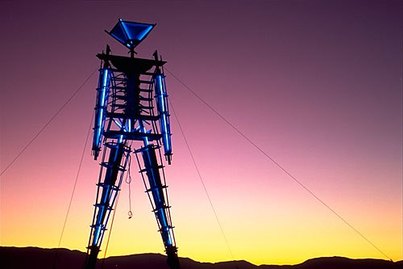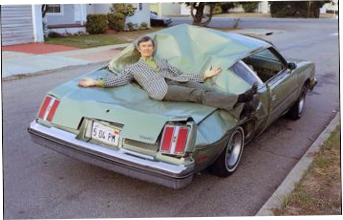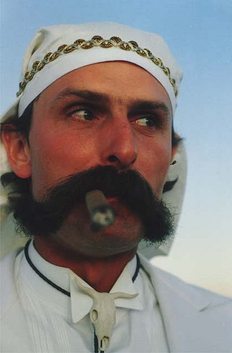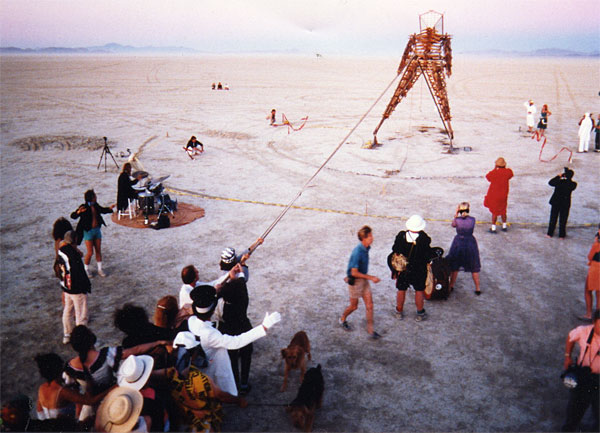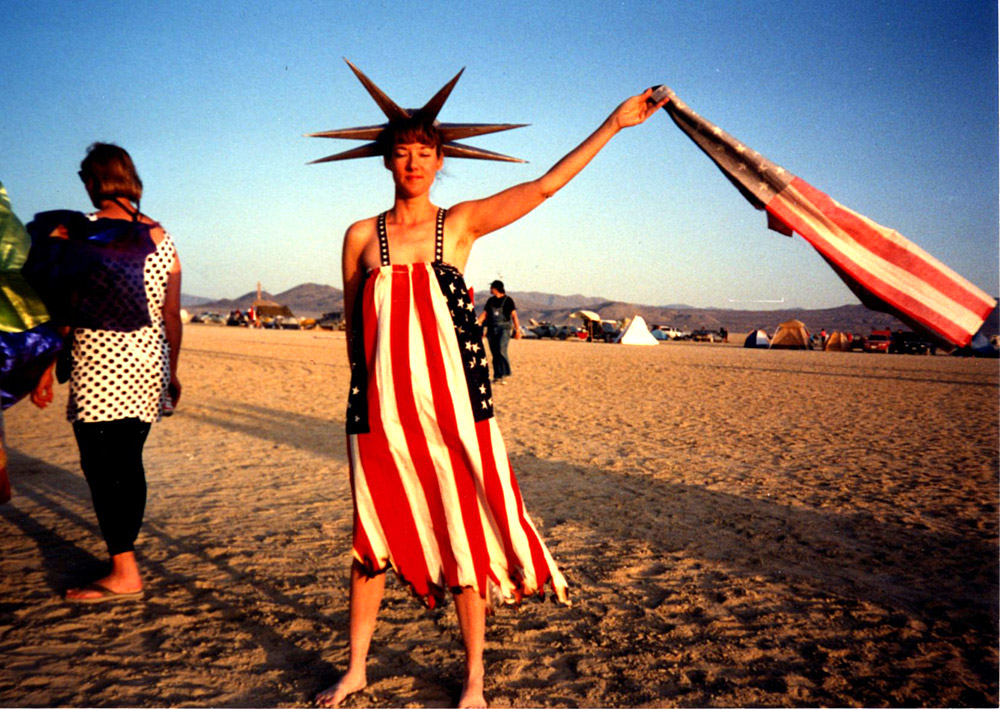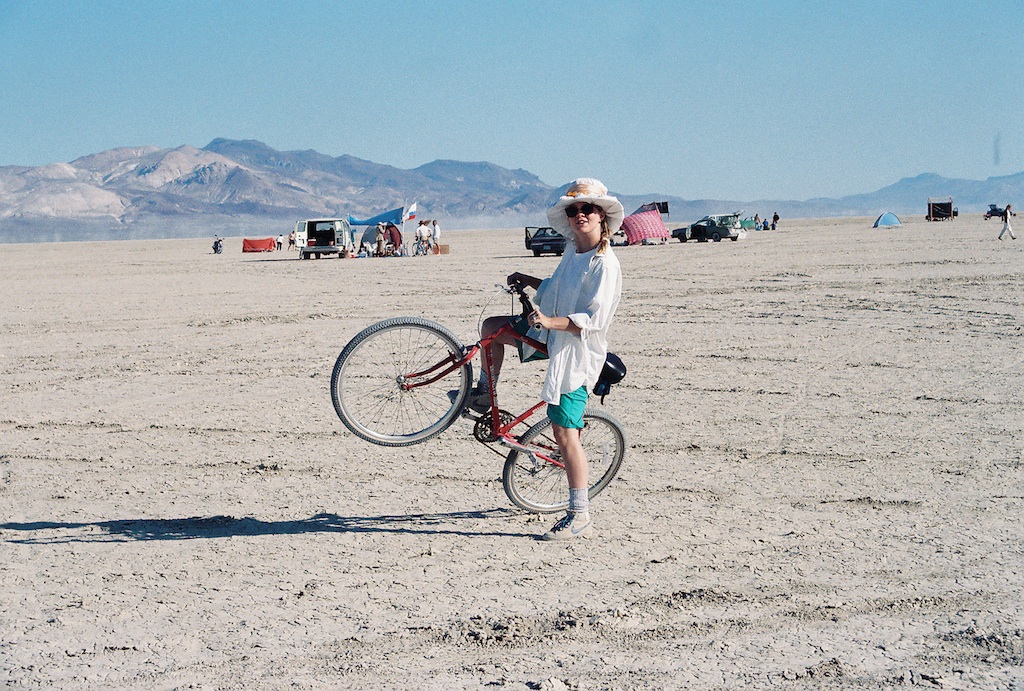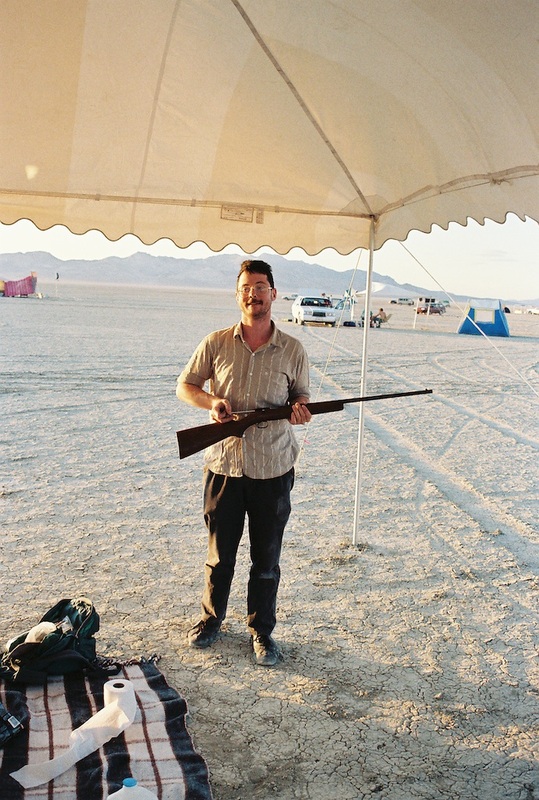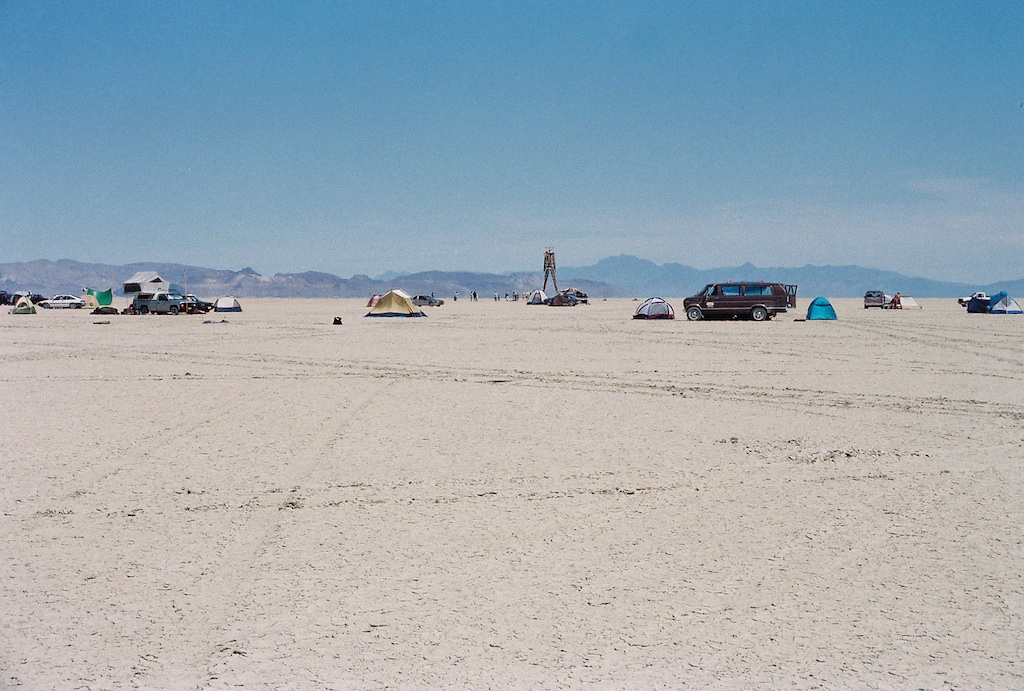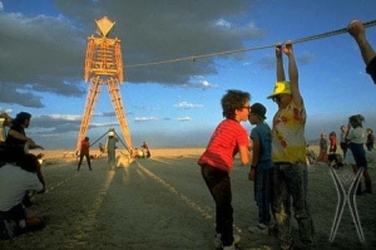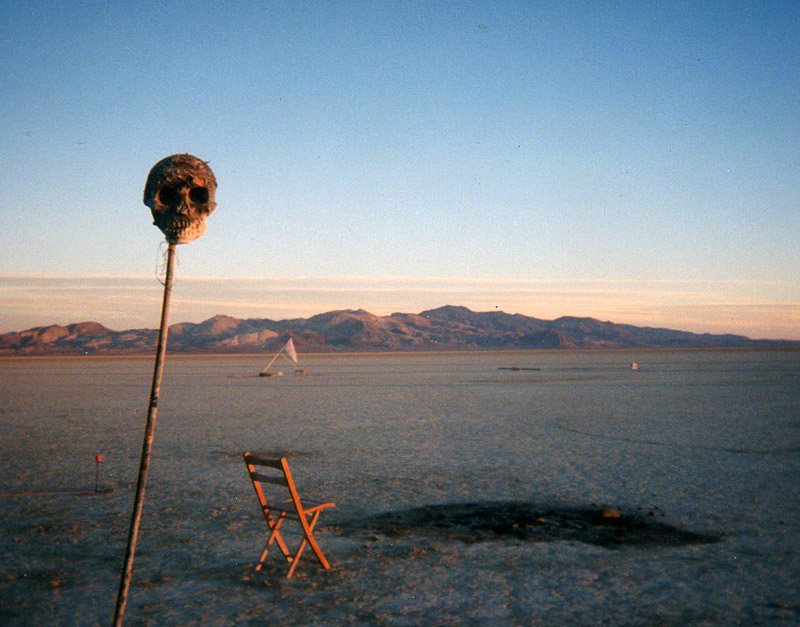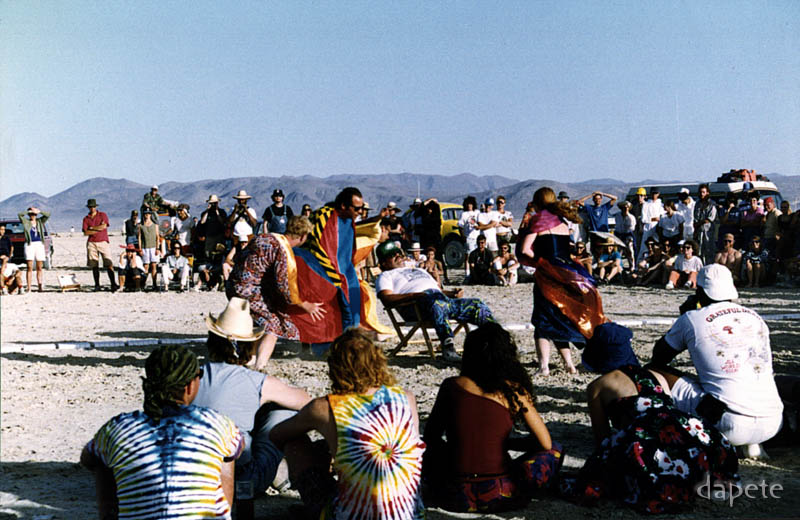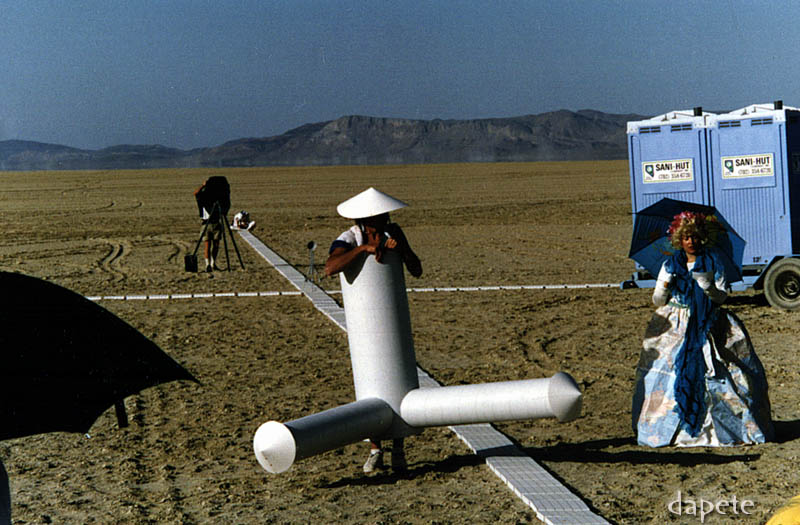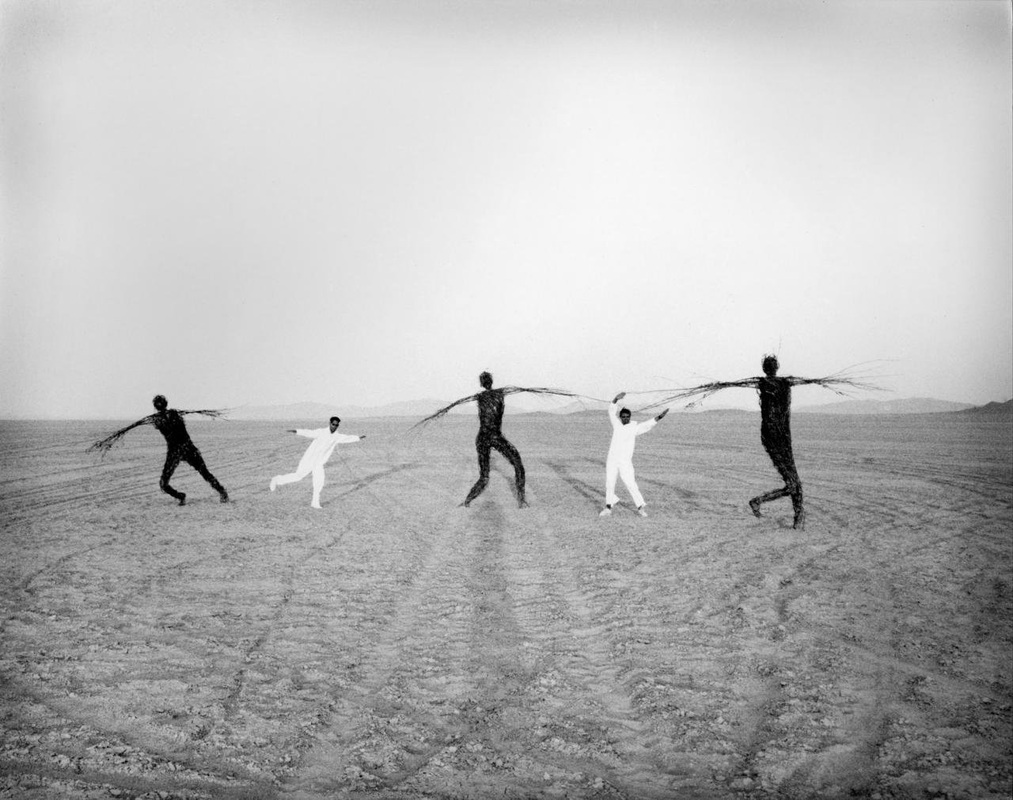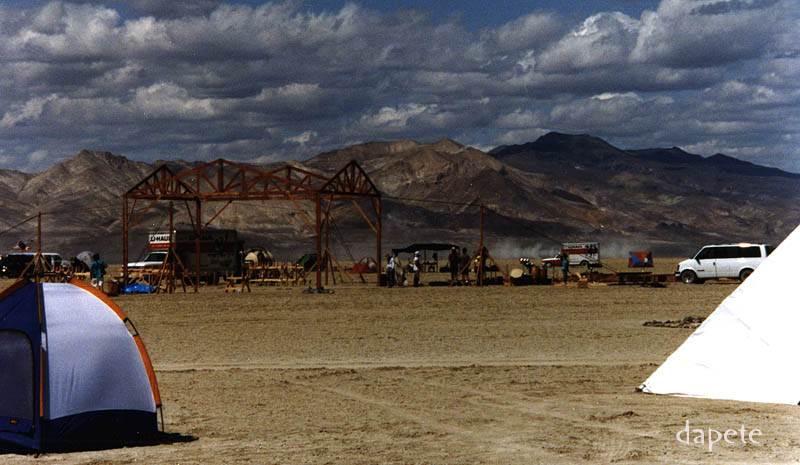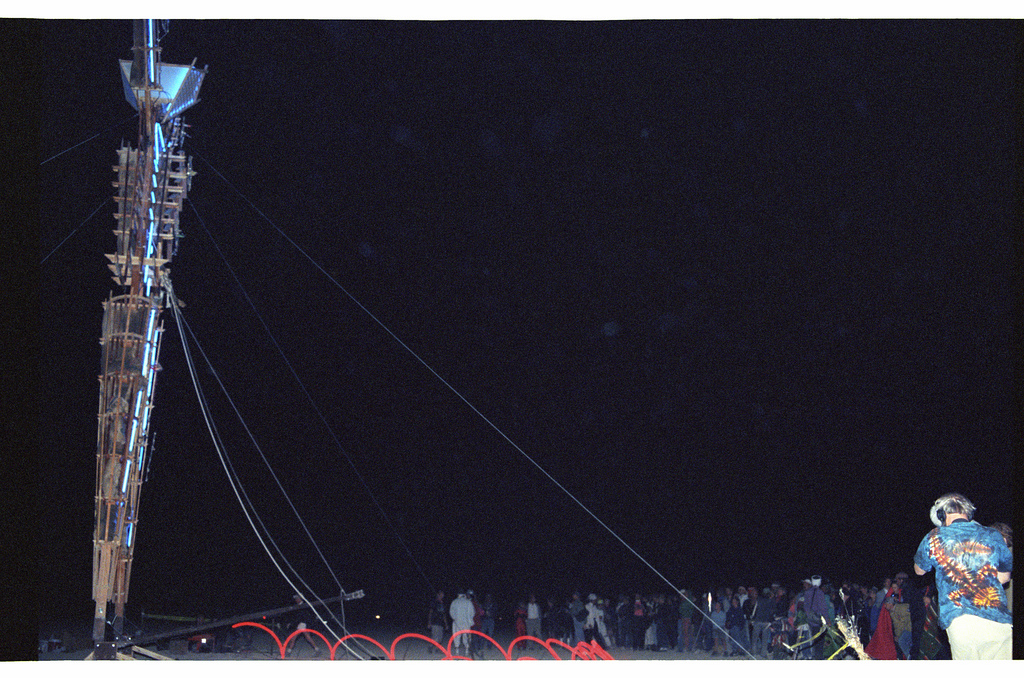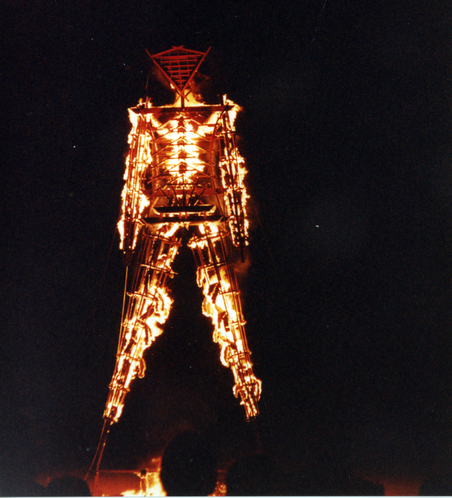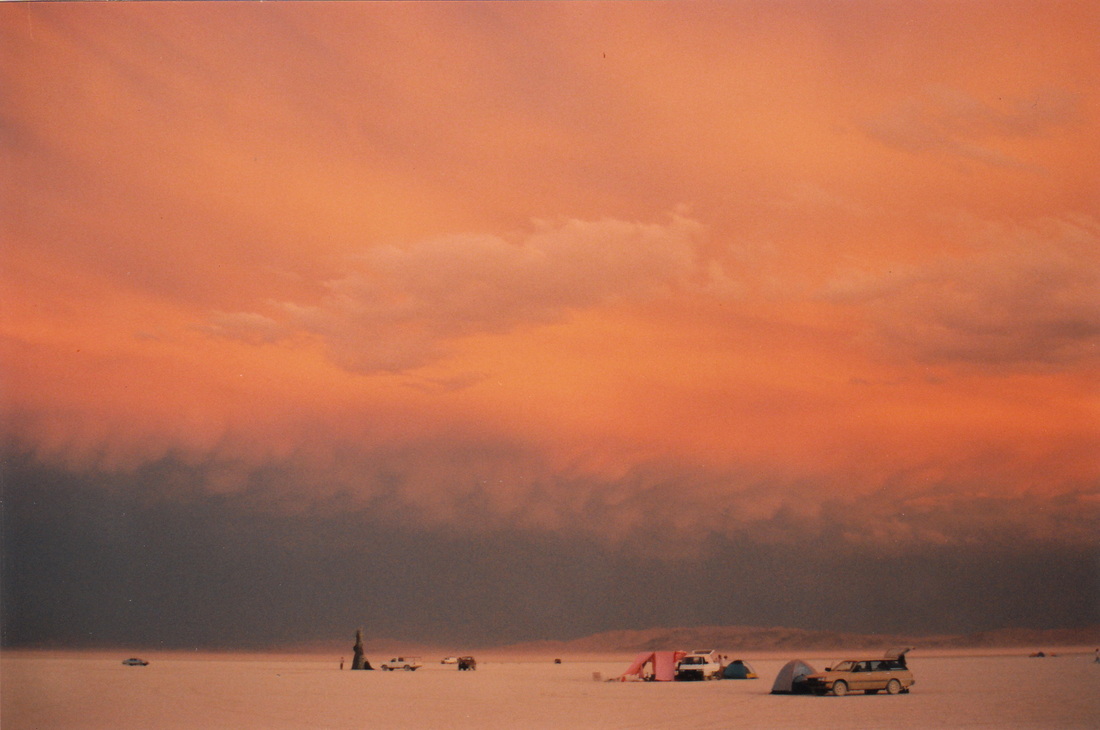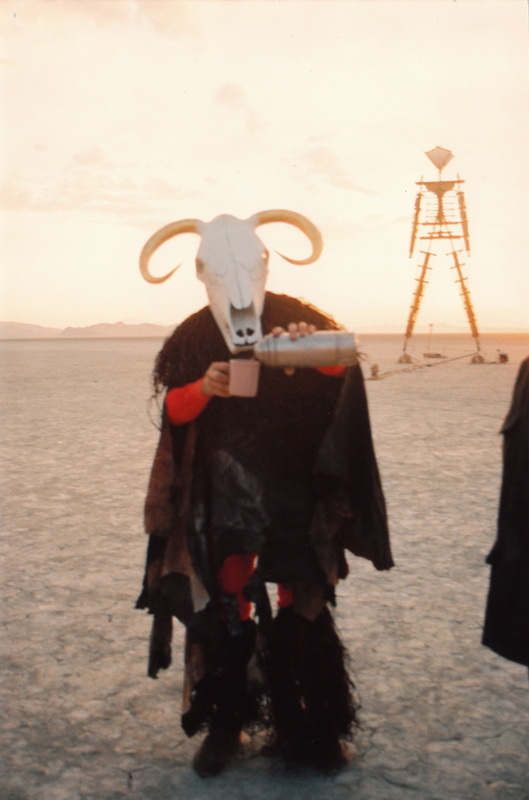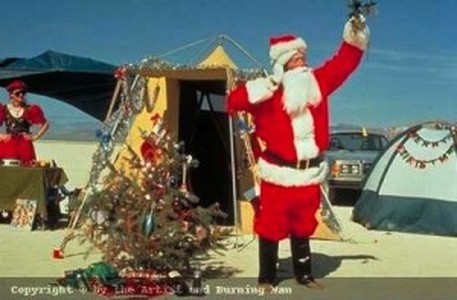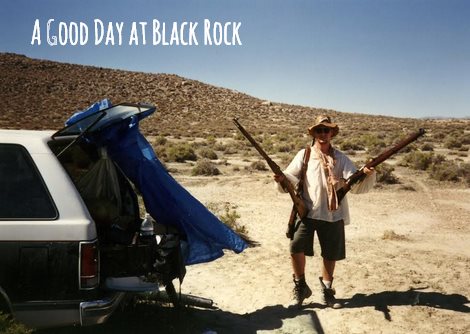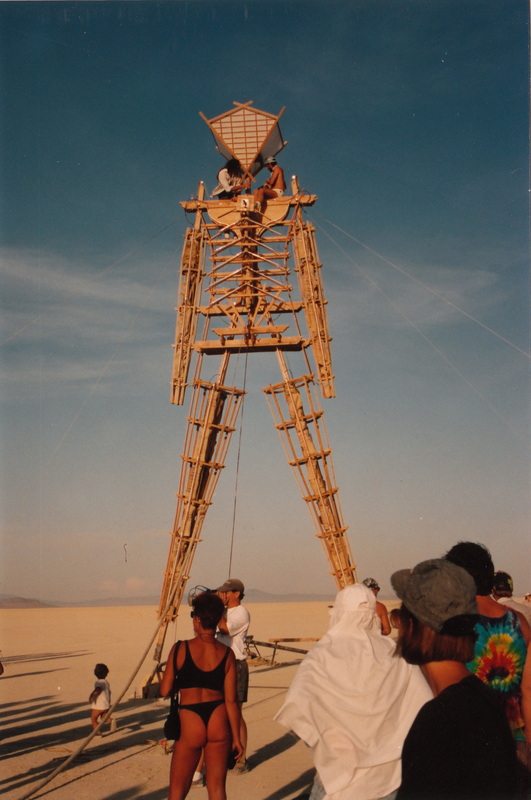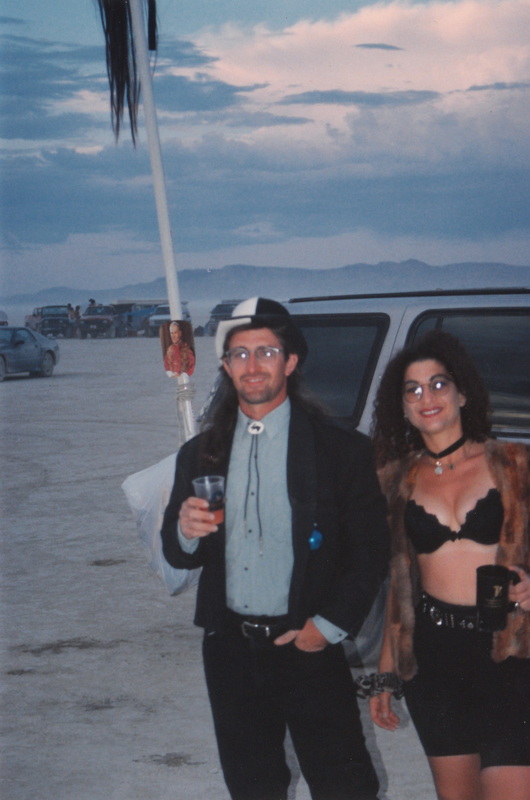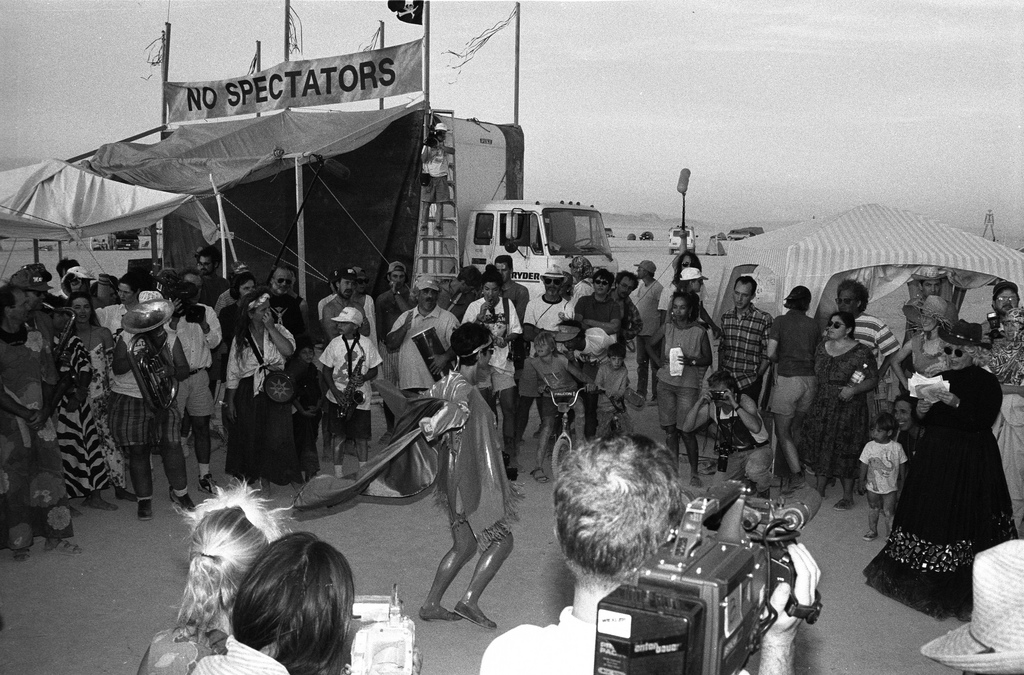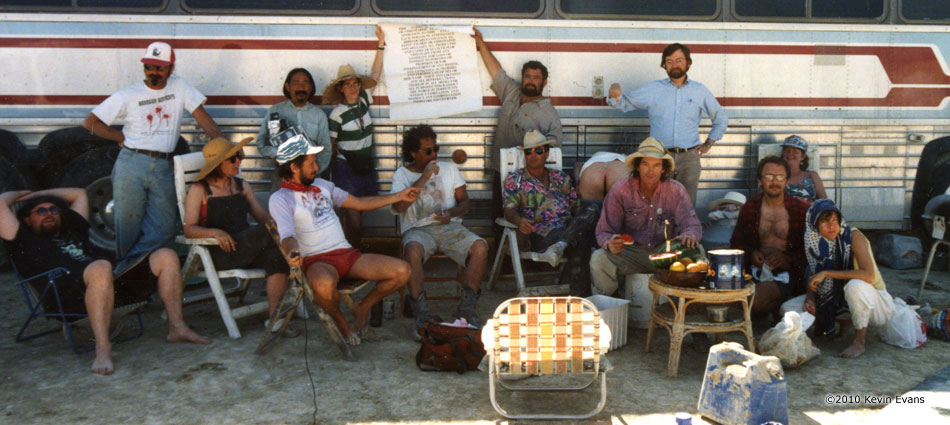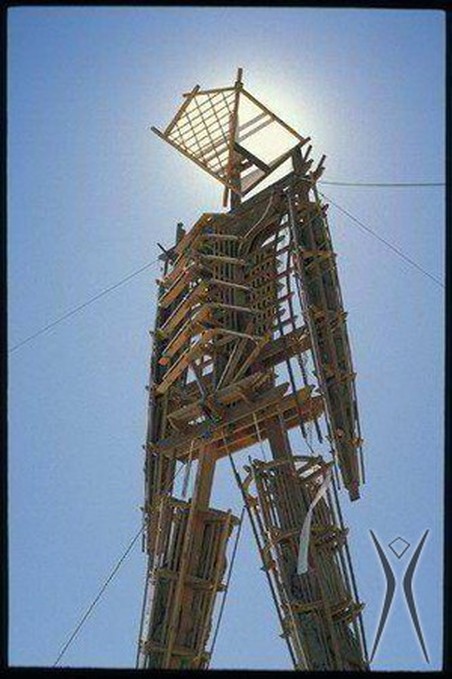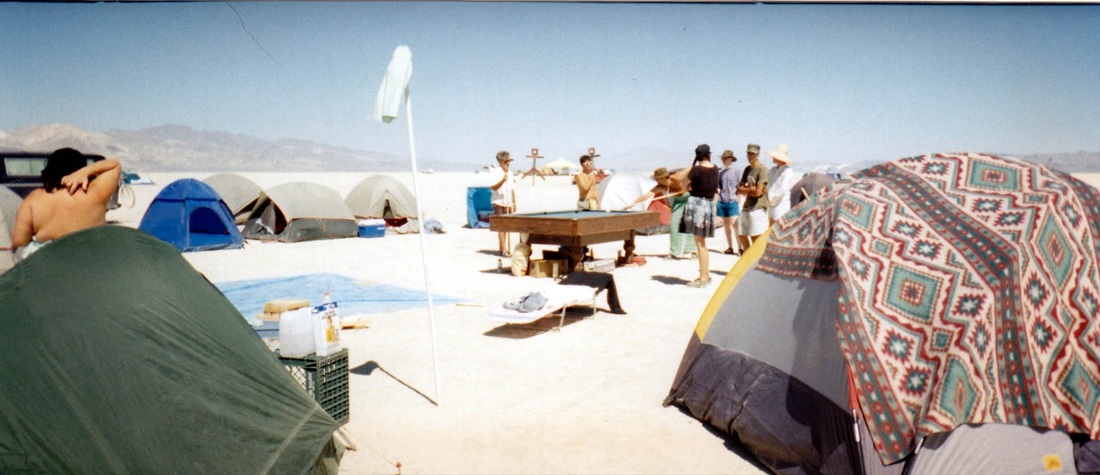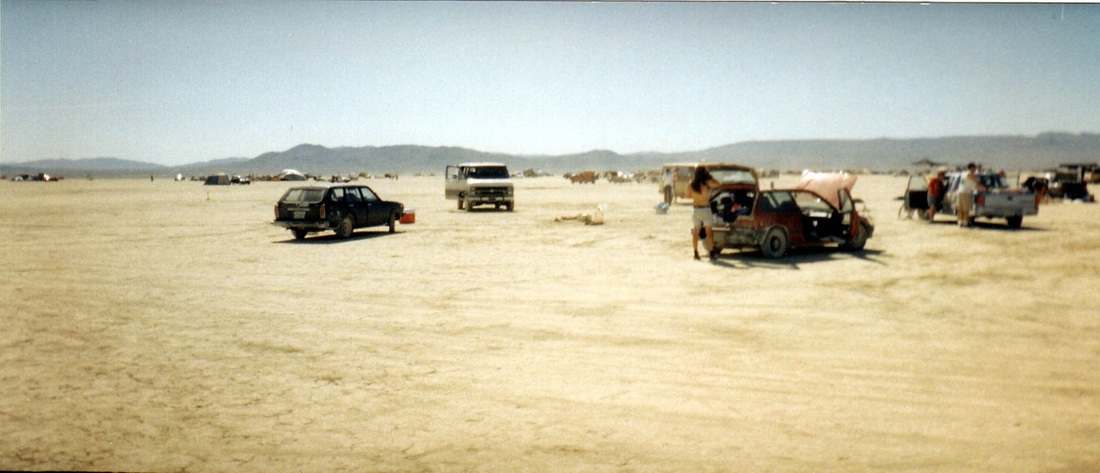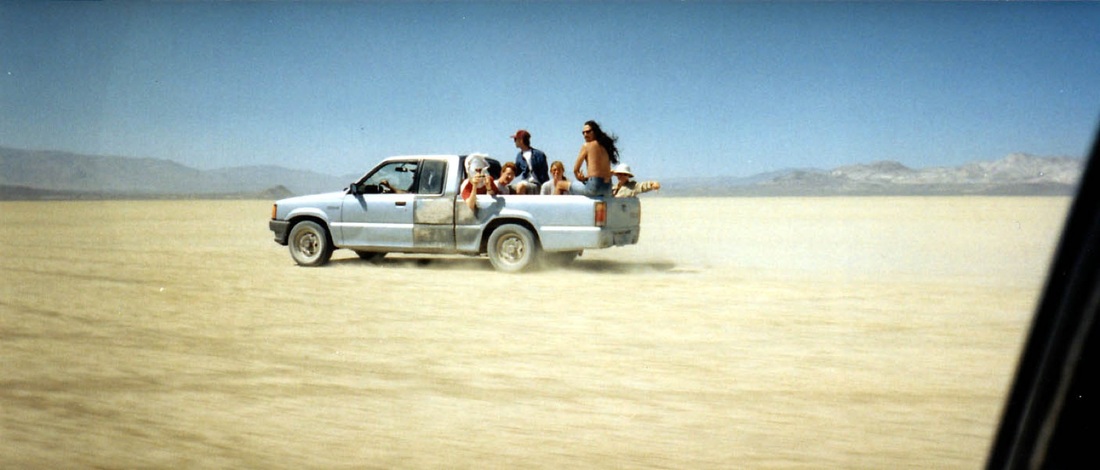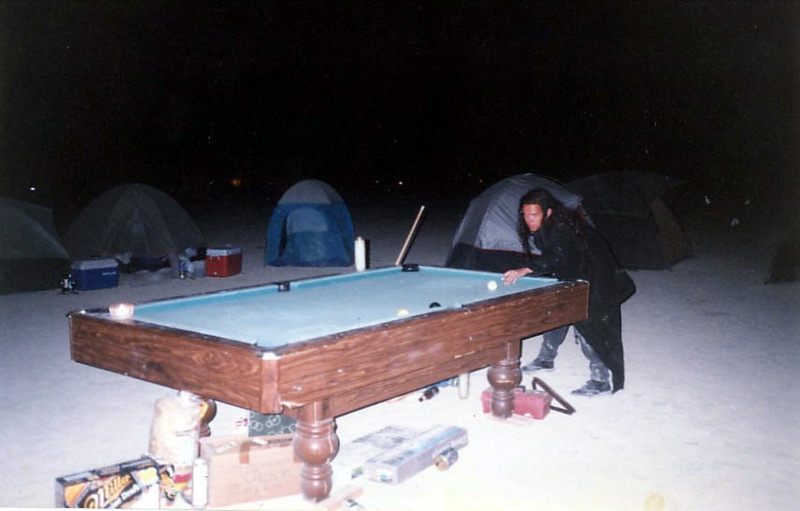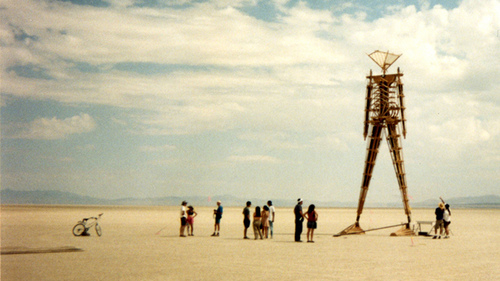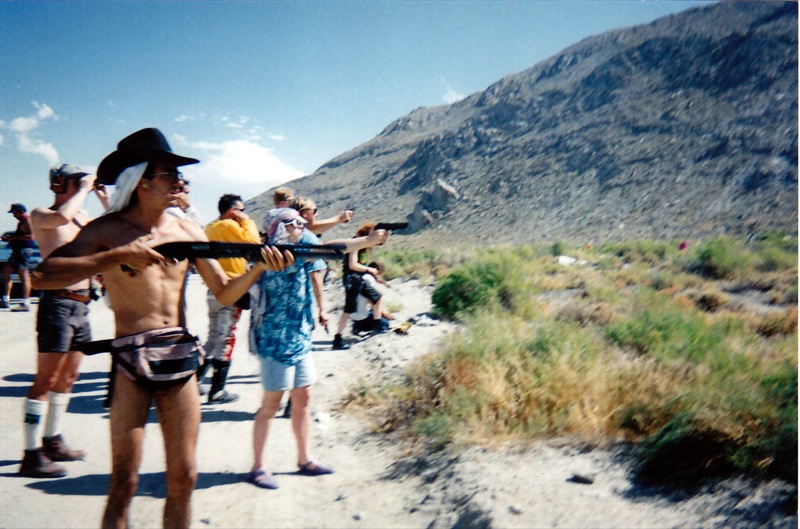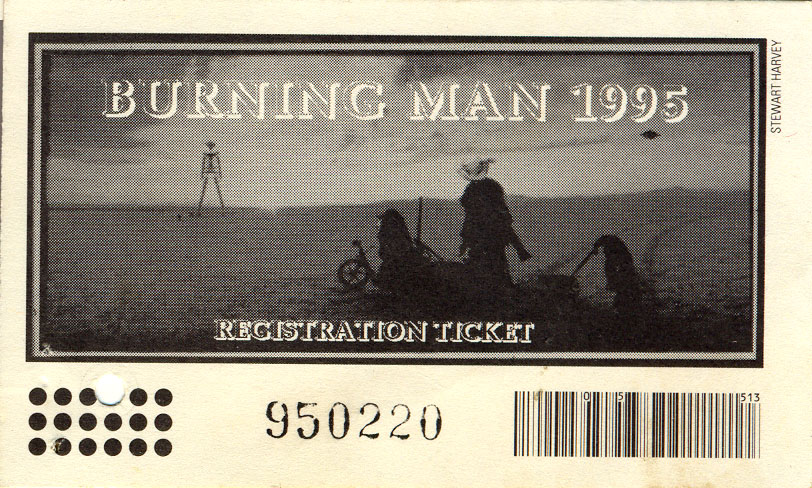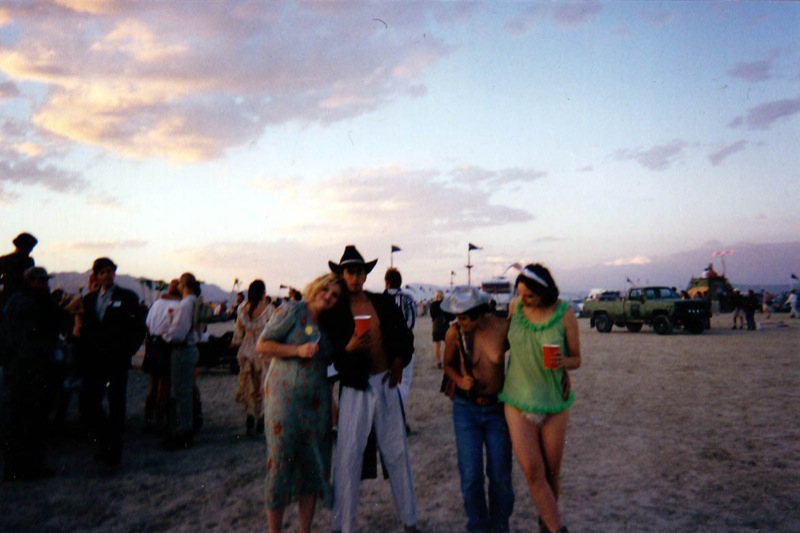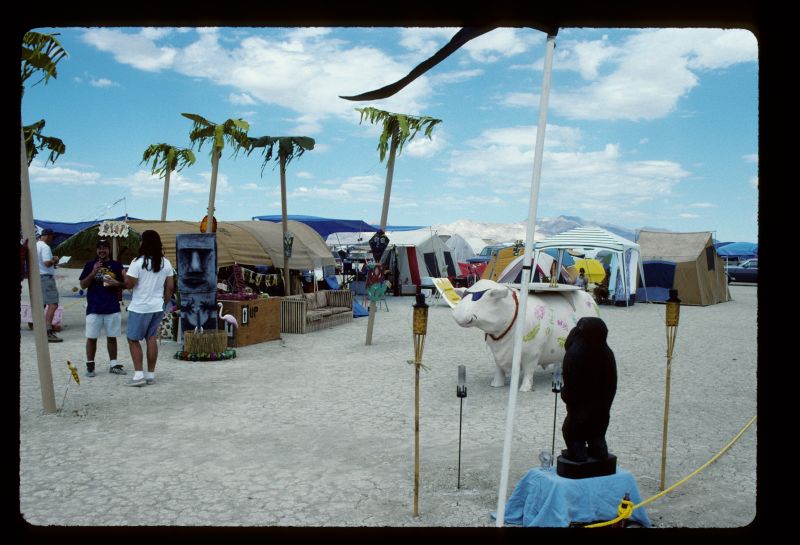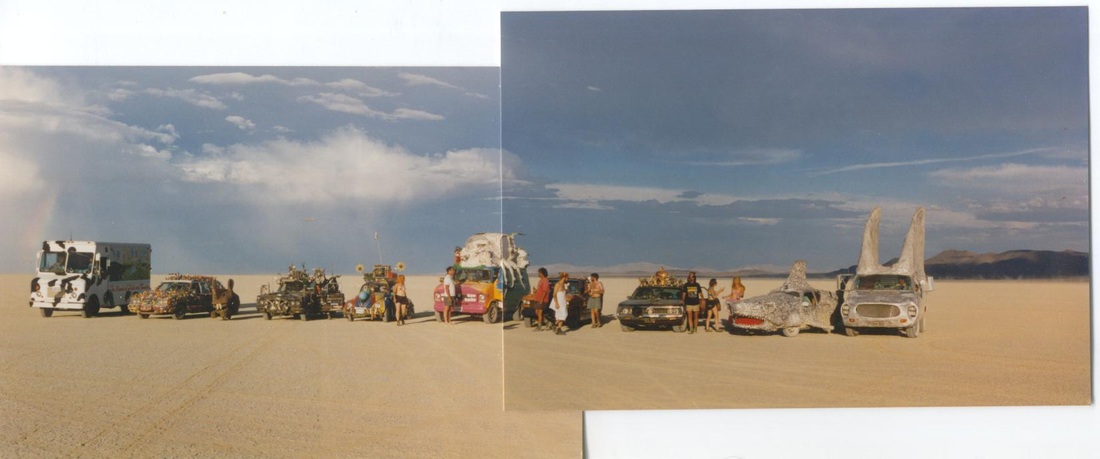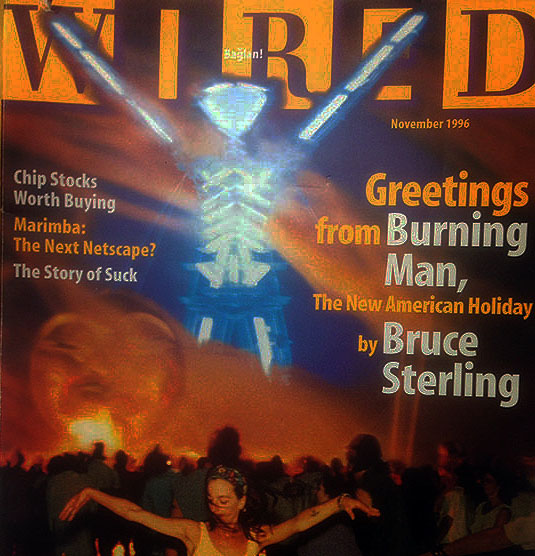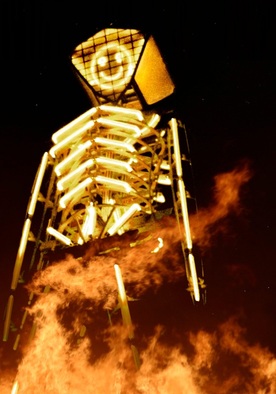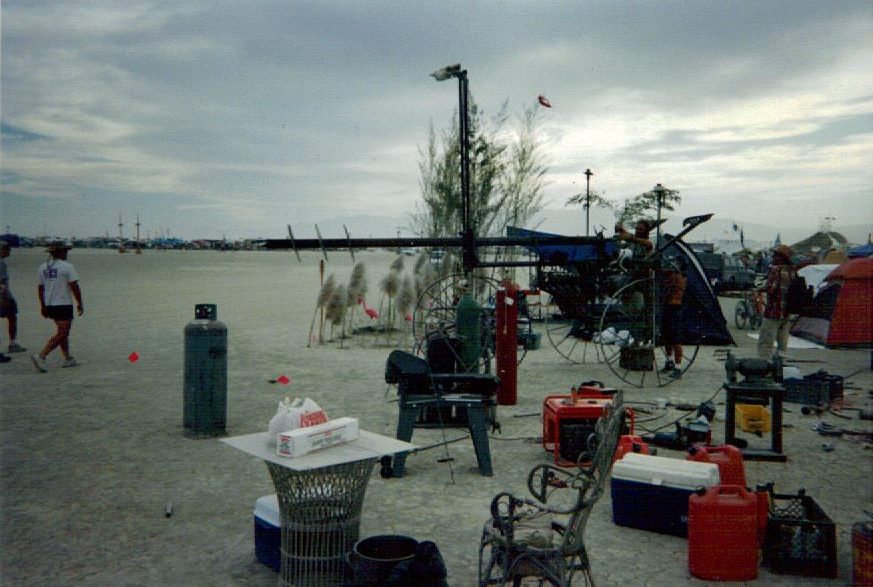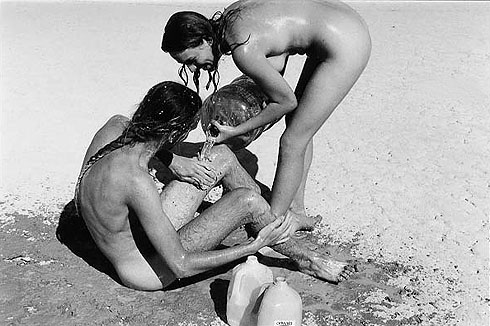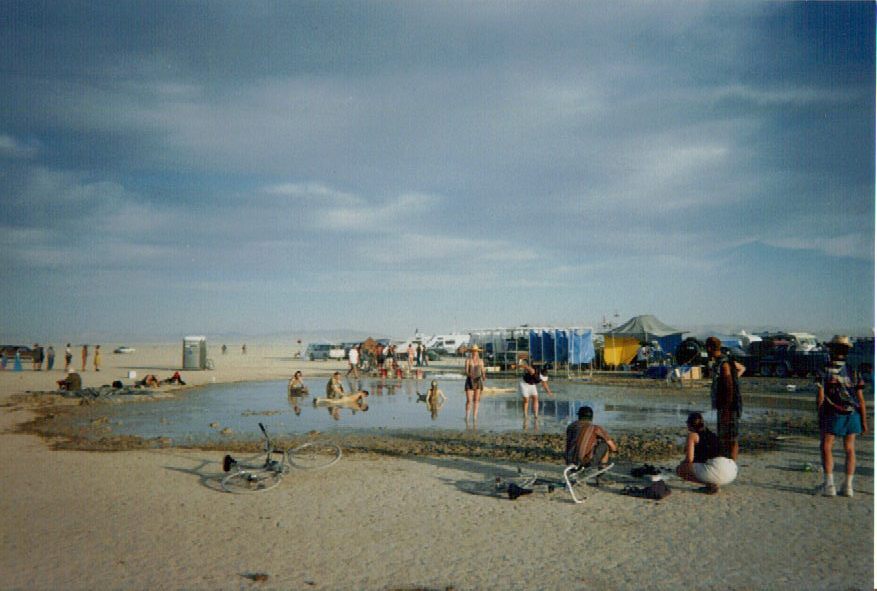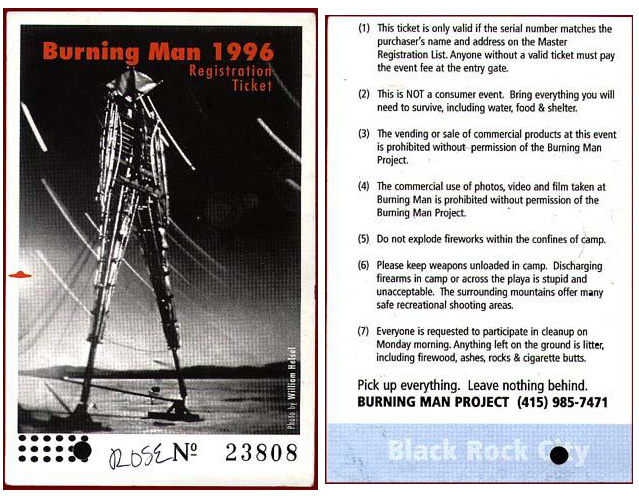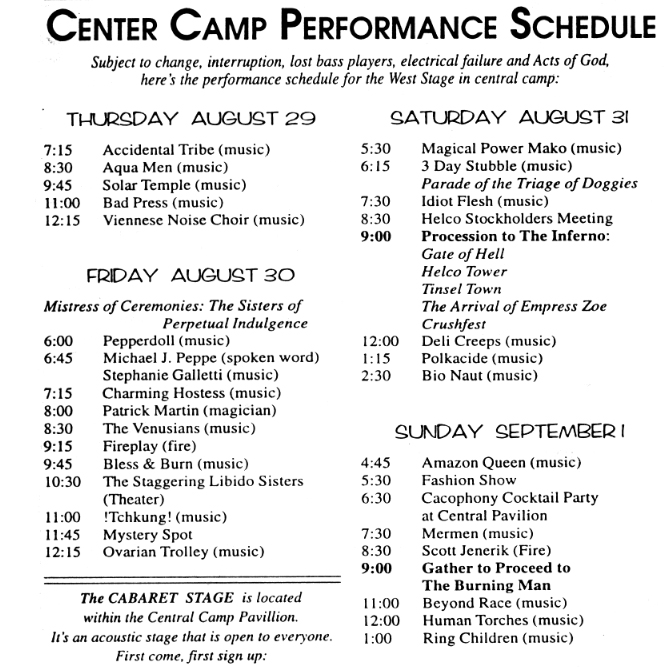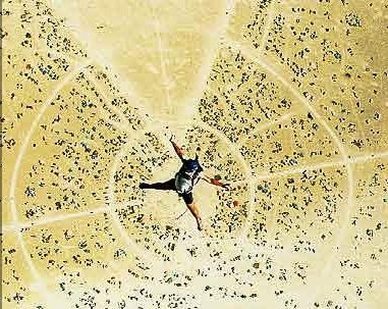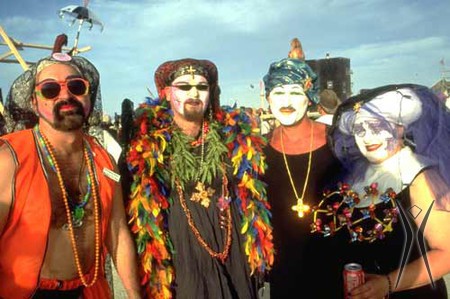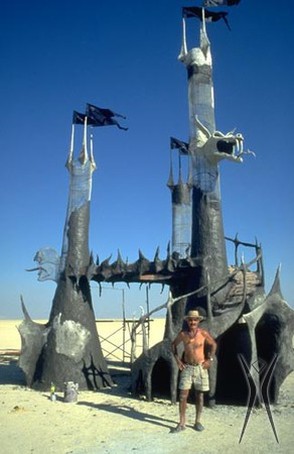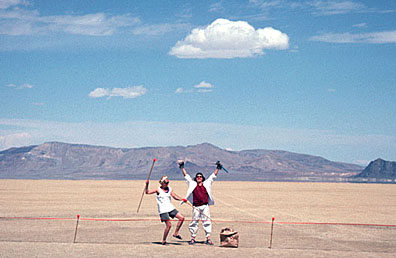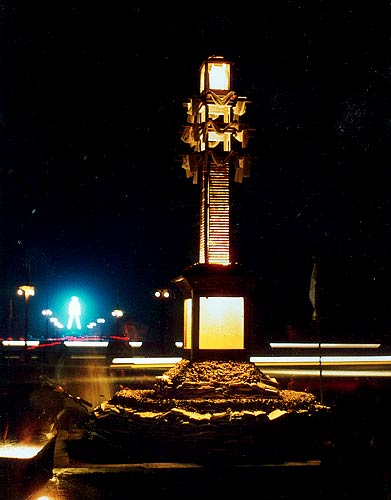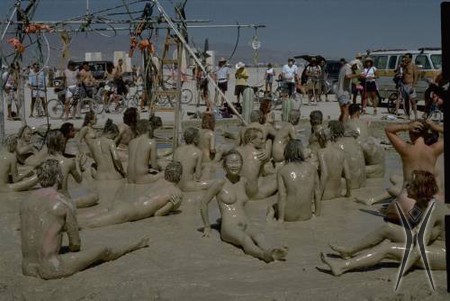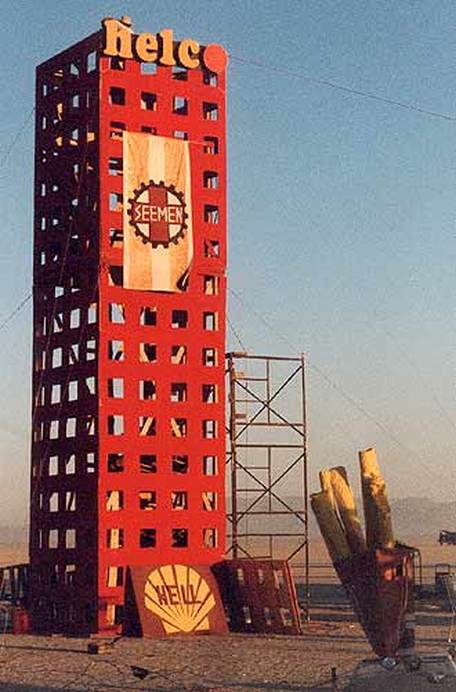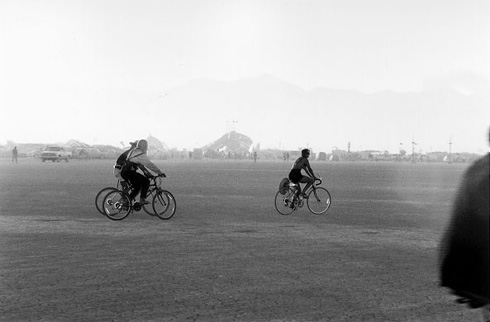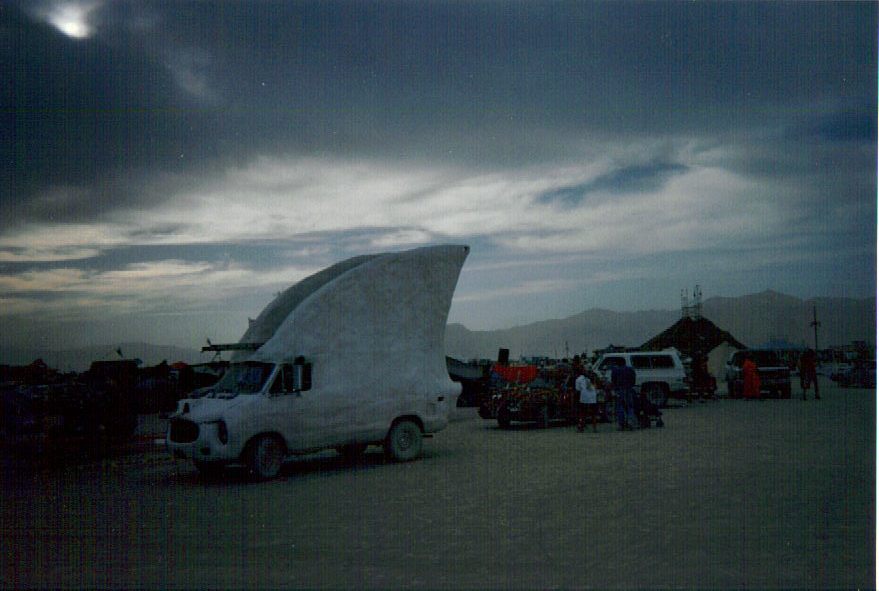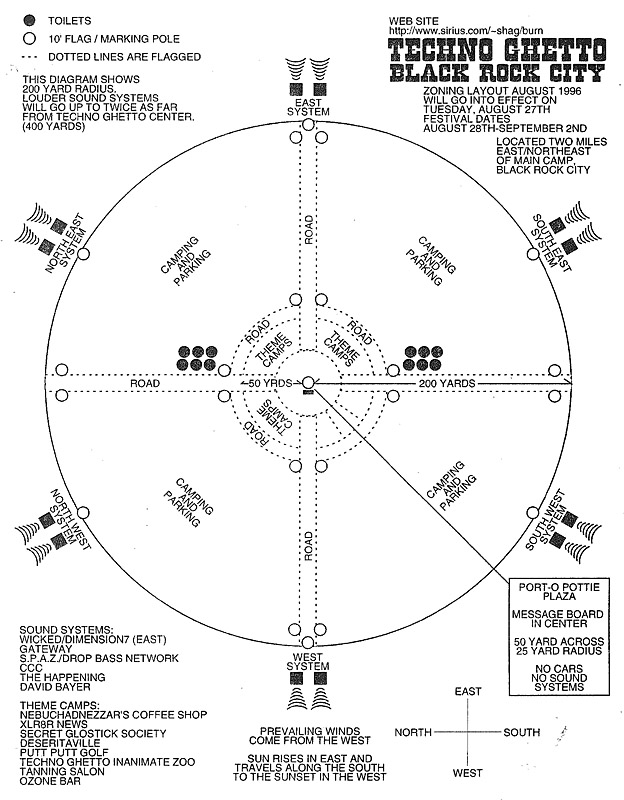|
|
In 1990, Burning Man unexpectedly moved to the Black Rock Desert after law enforcement wouldn't permit the Man to be burned on Baker Beach. Only about 90 people made the journey to Black Rock to see the Man burn.
In 1991, about 250 people watched it burn, which was down from the previous two years' population on Baker Beach. From here until 1996, Burning Man absolutely exploded, approximately doubling in size each year. |
A BIG credit for help in these early years goes to the Burning Man organization's own official Timeline. It's really well done and I highly recommend also checking it out. It's a little lighter on photos, a little heavier on text, and it's from the horse's mouth, so to speak.
1991: Black Rock Is Home
|
Population : 250
Man Height: 40 feet Ticket Cost: None This year, the Man was lit by a firespinning Crimson Rose, starting a tradition that continues to this day in the Conclave Fire Dancers performance that traditionally happens before the Man burns.
Those who were there also recall that 'art' was not the purpose in most of their minds. Peter Doty, for instance, in Brian Doherty's "This is Burning Man" said, "It always surprised me that people were doing art out there. I didn't think of it as something people would necessarily do. I thought of it as more of a camping trip/party type of thing. So anytime anybody did anything, it was like, 'Oh, wow, someone did something!' And back then, people actually slept at night. There wren't a lot of generators. In 1991, I'm not sure there were any generators." 1991 marked the first art car on the playa as well! Danger Ranger, founder of the legendary Black Rock Rangers, took a 1978 Olds Cutlass Supreme that had a crushed back end from a brick wall falling on it during the Loma Prieta earthquake, thought, "I bet it that will still run" and bought it. It became a conceptual art piece with a license plate reading 5:04 pm - the exact time the earthquake struck. A testament to the uncontrollable forces of nature. |
1992: The Black Rock Rangers
|
Population : 600
Man Height: 40 feet Ticket Cost: None 1992 saw Danger Ranger found the Black Rock Rangers. These bold men and women are veteran Burners who's mission is to help the rest of us. They're not here to judge us or prosecute us. In the early days, in particular, if you were out in the super deep playa on your own and got lost, or your car broke down, there's a good chance you were going to die from the elements. The Black Rock Rangers are here to help you.
The same year, Danger Ranger also produces the first issue of the Black Rock Gazette. 1992 was also the first year electronic music appeared on the playa. According to Brian Doherty's "This is Burning Man: The Rise of a New American Underground" the camp was organized by Craig Ellenwood of the early Oakland acid party crew Mr. Floppy's Flophouse. (I interviewed Craig in 2018 about this.) The headline act was Goa Gil, who played from Aphex Twin's "Digeridoo" on digital audio tape to a crowd maybe twenty-five, at most. Someone named Terbo Ted also reportedly had the pleasure of being the first person to DJ at Burning Man this year, when he "played on Friday afternoon to literally no one, with only ten miles of dust in front of me. It was awesome." (Minus the 10 miles of dust, this remains the experience for 95% of DJs at Burning Man today!) There's a fairly detailed article on the very earliest appearance of electronic music on the playa here. |
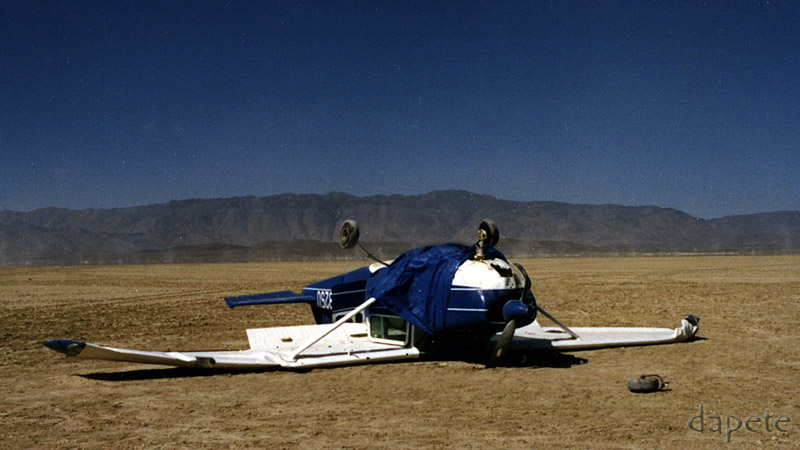
Someone tried to land on the playa and it did not go well. The front wheel assembly ripped off - playa was too soft for it. It sounds like everyone was ok, however, and the photographer reports partying with a passenger from the plane at the Burn later that night. She (passenger) was quick to point what a strange day she'd had. No doubt. Photo: dapete
1993: The First Theme Camp
|
Population : 1000
Man Height: 40 feet Ticket Cost: None By 1993 it was becoming clear that costumes or alternative/non-mainstream outfits were likely to become a big part of Burning Man, and indeed, they have.
Bigger than that, however, was the introduction of the theme camp to Burning Man. The very first one was a Christmas-oriented camp with 24 hour Xmas music, caroling, Santa Claus, etc. Reportedly, some people found the barrage of holiday music somewhat irritating. Dr. Lizard writes, of that time, "When Burning Man first came to the desert, it was extreme survival camping. Here we were, just a couple hundred of us, smack in the middle of some godforsaken nowhere. The alkali plain seemed to stretch to infinity. Our cars and tents were huddled close to each other, like a wagon train circled against the wilderness. Many of us brought freeze-dried food and camping gear. The Black Rock Rangers had guns….big guns. They patrolled the desert around our camp, keeping an eye out for those who might have wandered too far, into the very real dangers of the Black Rock Desert. |
|
|
The Black Rock Rangers, led by the intrepid Danger Ranger, were dressed in paramilitary “Lawrence of Arabia” style, with camos and headgear. Some had flowing robes. Most of the rest of us wore….khaki. Camping clothes. Shorts, fleeces. But everybody had been told to bring formal clothes for the black-tie cocktail party immediately preceding the Burn. There was something innately curious about being there, in that environment, with formal wear, sipping martinis and watching the sunset in the glow of generator-powered neon from the Man. It was so ridiculously heinous, so bizarre and hilarious, that nobody even laughed about it. It was so wrong, it felt right.
Sure i had some batik cotton pants from Bali that i couldn’t really wear anywhere except the Burn…or maybe the Health and Harmony Festival. There was the occasional guy in a sarong, or a woman with a parasol. Other people took advantage of the opportunity to wear something outrageous, or nothing at all, since we had created a community where people felt comfortable nude. The authorities weren’t really aware of us yet. There were a few guys in dresses, and of course there was the Java Cow, but that was for a ritual performance…. and i’m digressing again. Returning to the desert, it seemed everyone had picked up on that heinous juxtaposition of creature comfort in the desert. Kitchens grew elaborate. Freeze-dried became a thing of the past. No, we had to have chicken breast sauteed in a white wine – caper sauce, and champagne served – of course – in the good crystal brought from home. Disposable plates? No way. We had good china, and proper silver. Tuxedos and evening gowns for the cocktail party. Then came 1993. I will never forget the sunset before the Burn. We had our first radio station that year, and the entire camp was arranged around a circle – a deliberate circling of the wagons. For me, that was the year it all came together. That one circle was our first street, and the prototype for what is now Center Camp. Remember, the entire encampment was smaller than today’s Center Camp. We held the formal cocktail party in the center of the circle — there was no cafe. It was also the year of the first theme camp – Christmas Camp, with their fake snow and decorated Christmas trees, and their naughty, scrawny Santa (Peter? Whatever has become of you?) and their OBNOXIOUS high-volume caroling.
Anyway, cocktail party time. 1993. Sunset. Center circle. The clouds took on a brilliant magenta hue with orange highlights. The Man was lit, blue, to the East of us, standing taller than the mountains. We were all decked out, in our heinously formal jackets and gowns. I was watching the beautiful Calico Mountains to the west, with their streaks of white, orange and red soil. The sky cast a magical glow over the proceedings. And then….then they arrived. From one side of the circle, arm-in-arm, a troupe of fully decked-out and frocked-up drag queens from San Francisco came sauntering up to the party. All eyes were on them. They had pulled out all the stops. Velvet corsets, fishnets, enough make-up to embarrass Mary Kay herself. Boots, heels…stilettos. Vermilion, burgundy; skirts, lace, garters. In the glow of the sun-streaked sky their outfits were positively stunning. The conversation ceased, and something — something just *clicked*. It all fit so perfectly together. This purely gratuitous display of ostentation became the modus operandi of the entire community.
The circle opened, and the Queens (Sisters of Perpetual Indulgence perhaps, or an offshoot? I’m not sure) were handed cocktails and mixed in with the rest of us. It was at that moment, I think, with those totally camped-out, over-the-top queens grinning at us, that everyone realized that the Burning Man Experience we had created was a *forum*. Not a festival, not a party, not a show….a forum, where you could say or do or build or *be* anything you ever wanted to say or do or build or be (as long as it didn’t hurt anybody) and it would be ok. Not just ok…someone would be bound to come up to you and say “That is the most awesome thing i have ever seen, thank you so much for doing that.”
The next year, most of us came back with costumes." |
1994: Expansion
|
1995: Center Camp
|
Population : 4000
Man Height: 40 feet Ticket Cost: $35 The fledgling Center Camp, under P Segal, began selling coffee this year.
Piss Clear, a photocopied 'zine consisting of two 8.5"x11" paper folded and stapled together, launched its first issue this year. A couple hundred copies were printed of the 'magazine' with a particularly satirical view on the world and on Burning Man. |
|
One of the first documentaries was produced on Burning Man this year, and CNN began annual coverage of it.
Theme camps began to dominate central camp design. Dust, wind, and lightning provide a dramatic background for the year. Watch the video on the left for an idea of what Burning Man was like in 1995. It's a great piece of history. (Warning, some NSFW scenes.) There's one part where a couple girls complain that it's too big, and that they should have come a couple years ago when it was smaller. Chuckle-worthy given the scale of BM today. |
1996 - The Inferno (First Official Theme)
|
Population : 8000
Man Height: 48 feet Ticket Cost: $35 This was both one of the Burning Man's most pivotal years, and a very hard year for the Burning Man organization, with the population again doubling and cracks beginning to show as a result. Doubling, again, to 8,000 people, Burning Man was now a major....thing... and dwarfed the size of the local communities. There were ~130 theme camps this year, a big jump over previous years.
One person - artist Michael Furey - died when he crashed his motorcycle into a van, and three other people were seriously injured when a car drove over their tent. For obvious reasons, this would be the last year of unrestricted driving at Burning Man, and the last year any guns were permitted (they were banned at Center Camp this year). Some old-time Burners consider 1996 the peak of Burning Man, as events did force substantial change on the event and the organization after this year, and there's no doubt the character of the event was substantially different going forward than it had been in the early 90s. More organized, less anarchic, for better or worse. This was the first year with an official theme (The Inferno), a tradition that continues to today, and the first year the Man was on a platform - in this case a 10' one with single steps and hay bales. John Law put a neon smiley face on the Man, and the Helco tower was probably the most notable piece of art there that year. In a series of pre-Burning Man events in San Francisco various artists and Cacophonists put on plays and subplots all based on Dante's Inferno and all revolving around a central story about a hostile takeover of Burning Man by Helco and its diabolical CEO, Papa Satan. Famously, after the tower was lit, John Law rode a zipline down from the six-story top, in echoes of his membership in the infamous Suicide Club. There's video of the moment, with the crowd going wild, in the video below/left. Great stuff. |
|
You have got to watch the video above. The super-Christian tv show "The 700 Club" with noted evangelist asshole Pat Robertson, visits Burning Man. They are predictably horrified.
|
This would also be the first year the Nevada Sanitation Department arrived to cite BM for infractions of safety codes, such as having naked employees (seriously).
After some disagreements between electronic music fans and others in 1995, Turbo Ted organized the "Techno Ghetto" about a mile north of camp in order to keep the large sound camps away from the general population - there had been some issues/complaints the year previously. This didn't work out well. Harley K. Dubois said, one of Burning Man Project's founders said, "The rave was moved downwind and a mile out, with a clearly defined road leading to it. Though the previous year's issues were resolved, the distance and lack of connection with the rest of the city proved to be problematic. A breakdown of civic standards and community created chaos, ultimately resulting in serious injuries occurring to rave participants. The Burning Man organizers, and I in particular, were devastated by the experience, and vowed that no such incident would ever occur again." Harley said in an Oral History of Burning Man,"We were always looking for the tipping point. When does it not work anymore? In ’96, we found it." Danger Ranger: "It started during the setup days. Michael Furey, a neon artist, was in the town of Gerlach, drinking at the bar. Toward dusk he got on his motorcycle to go back to camp, and people tried to convince him to put his bike in a truck, but he declined. There was somebody in a van driving back at the same time, and Michael started doing these runs at the van to see how close he could get." Vanessa Kuemmerle, an early insider, said, "It was that twilight hour. I had gone into town and was at a gas station where there were a whole bunch of people trying to figure out how to get to Burning Man. There was a caravan of maybe 10, 20 cars. Beautiful sunset. At some point I see a flashing light out on the playa. Is it really far away? Close? And then all of a sudden, whoom!—I see that it’s John [Law]’s white van. A guy called SteveCo was driving. I pull over and stop the car. SteveCo stops the van and just looks at me and goes, “Mike Furey’s dead.” Furey had been playing chicken with the van and was basically decapitated by the side mirror. There wasn’t any ambiguity there." John Law: "Furey killed himself, but it was Larry’s response that made me certain I was done after that year." Kuemmerle: "We’re waiting for a coroner and the sheriff. An SUV comes up, or a minivan, and Larry and a few other people get out. Larry bursts onto the scene and he says—I swear to fucking God—four times in a row: “There’s no blood on our hands!” My jaw was on the playa. It was one of those moments of looking into someone’s mind and not being too excited about what I saw." Joe Fenton, one of the early Black Rock Rangers: "Larry’s way of dealing with 1996 was to try and control what was getting to the media. When Furey died, the first thing Larry did was look at his watch. He made sure to say it happened at 11:30 the night before the event officially began. So it didn’t happen at the festival but before the festival, as if Furey’s death was somehow not related. It was a stupid, alcoholic, moronic death. But you couldn’t deny that he chose this event to die at." Chris Radcliffe (Cacophonist): "Burning Man had become Larry’s whole life, so for John to say it’s over—that was a problem. Larry started politicking during the festival, telling me that John was handing out speed to volunteers. I told him if he repeated that, I’d strangle him. And he did. So I did." Harvey: "That is an invention. Chris never threatened me with violence. He’s a fertile source of ruses. When it came down to it, there was this argument in ’96 that divided myself and others. John was among them. There were members of that crowd who put out a T-shirt that said BURNING MAN: WOODSTOCK OR ALTAMONT? YOU BE THE JUDGE. You could tell they were secretly rooting for Altamont." Harvey: "What finally occurred in ’96 was a question about two different visions of what Burning Man should be. Should it be civilized? Or should it be, essentially, a repudiation of order? If it’s a repudiation of order and authority, and you’re the organizer and it involves thousands of people, what does that mean for you? What kind of a moral position is that to be in?" Law: "Of course it had to change. We knew better than anyone, because we worked hard to keep everyone safe. But there was an opportunity there to say, Don’t make it bigger. Why does it need to be thousands? Keep it to a size where you know who you’re dealing with." Chicken John, early Burner: "We didn’t finish cleaning up that year until October 3, a full month later. When Larry left—I think it was the second morning after the burn—I was actually relieved. But back in the city, he was telling a bunch of artists that they’d see $500, or $300, or $200—and that John Law would give them the money when he got back. Only John spent everything he had left on dumpsters and keeping us alive out there. It got personal. Larry wasn’t doing the work, we were. All while he was setting John up." Law: "No one who goes to Burning Man today is going to care about a bunch of old farts who are mad at each other because the band broke up. But they should know who they’re dealing with. Larry’s no saint. He’s also no visionary." Danger Ranger: "That was the year John Law decided not to do it again, and the accidents were really traumatic for those of us who’d responded to them. But afterward I looked at everything that had happened and realized that, by and large, people there had an incredibly wonderful time. I decided to keep that perspective. Rather than not do Burning Man anymore, we needed to keep it going." The strain of the event this year caused a serious and permanent rift between the Burning Man founders. John Law would never return to Burning Man. Burning Man had reached its tipping point, and it was pretty obvious to everyone that it couldn't continue in its present form, especially given its growth rate. The infrastructure and organization weren't adequate to continue holding a rapidly growing event. To add to their woes, the Bureau of Land Management (who manages the federal land of the Black Rock Desert) found that Burning Man had violated 10 of 16 stipulations, and an injury claim drove up liability coverage by a factor of six. Plans began to relocate Burning Man to the nearby Hualapai Playa and the privately-owned Fly Ranch for 1997. Great 'promotional' video for Helco.
|
HTML Comment Box is loading comments...

